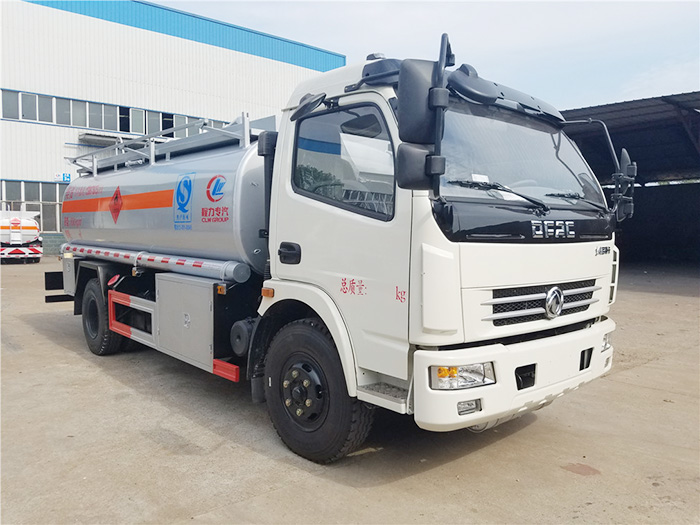Precautions for usage of small fuel tank trucks
Time:2019-07-16
Views:3929
1. Small tank trucks should be treated in time after being stained with dirt. The car is exposed to sunlight radiation and acid rain during the use of the car. It is easy to combine various corrosive dirt such as cement, grease, mucus, asphalt, sap, insects. The formation of stubborn stains, and then easy to make the paint surface dull, lacquer oxidation, shorten the life of the tanker. Washing can not be washed with detergent or detergent. Because of its alkaline content, long-term use can make the tank paint tarnish, dull, cracked and rusted. Special crystal clear liquid or car wash should be used
2. The interior of the tanker should be cleaned frequently. It is usually affected by external factors such as dust, sand, smoking, passenger sweat and air conditioning circulation, which causes the air in the cab to be infected, and then the bacteria grow and even produce unpleasant smell. The rubber is aged and the meter is out of order. It is recommended to do a cleaning treatment every two or three months.
3. Short repair: For the tanker failure, under the premise that the conditions permit and ensure reliable driving after repair, the method of “repair” should be adopted. For example, if the connecting rod bearing is burnt out, repair it with solder and then use a small knife to repair it to normal fit.
4. Tanker plugging: It means blocking the oil leakage, water leakage and air leakage. For example, the leakage of the fuel tank is glued with epoxy resin or soap, and the perforation can be blocked by a wooden plug, and if necessary, it is tied with a wire or a rope.
5. Replacement of tank trucks: When a certain component is damaged and cannot be driven normally, it can be replaced by parts that do not affect the driving on the vehicle or locally made parts. Such as: use a belt, backpack belt to make a homemade fan belt, instead of a damaged fan belt.
6. Short circuit: The circuit is faulty. A certain component in the circuit is damaged. It can neither be repaired nor replaced unconditionally. If it is allowed to be short-circuited, it is short-circuited. The short-circuit method cannot be used for a long time. When it reaches a condition, it is necessary to replace the damaged component in time.
7. Disassembly: that is, the damaged parts are removed without affecting the driving. For example, if the generator is damaged, it can be removed, and only the battery is used to supply power to the ignition system.
8. Cut off: Disconnect the damaged circuit or gas path. For example, if a wire is discharged from a certain place of iron, it can not be removed at a time, so that the fire line can be suspended and powered off, and only the ignition system is powered, and the power failure first aid is implemented.
8. Supplement: It is to increase the supplementary method. When part of the damage of the machine is lost or the clearance is too large, it may be considered to add some other parts to repair the first aid. For example, when the tubing is broken and cannot be blocked, the damaged part can be cut off, and the rubber tube or the like is placed on both ends of the tubing to be turned on.
9.Bundling: is the banding method. When there is a failure that requires fastening or demobilization, consider tying with ropes, iron wire, wooden sticks, etc.
10. Replacement: is to replace spare parts. Whenever you get out of the tanker, bring as many spare parts as possible to the parts for emergency replacement.

2. The interior of the tanker should be cleaned frequently. It is usually affected by external factors such as dust, sand, smoking, passenger sweat and air conditioning circulation, which causes the air in the cab to be infected, and then the bacteria grow and even produce unpleasant smell. The rubber is aged and the meter is out of order. It is recommended to do a cleaning treatment every two or three months.
3. Short repair: For the tanker failure, under the premise that the conditions permit and ensure reliable driving after repair, the method of “repair” should be adopted. For example, if the connecting rod bearing is burnt out, repair it with solder and then use a small knife to repair it to normal fit.
4. Tanker plugging: It means blocking the oil leakage, water leakage and air leakage. For example, the leakage of the fuel tank is glued with epoxy resin or soap, and the perforation can be blocked by a wooden plug, and if necessary, it is tied with a wire or a rope.
5. Replacement of tank trucks: When a certain component is damaged and cannot be driven normally, it can be replaced by parts that do not affect the driving on the vehicle or locally made parts. Such as: use a belt, backpack belt to make a homemade fan belt, instead of a damaged fan belt.
6. Short circuit: The circuit is faulty. A certain component in the circuit is damaged. It can neither be repaired nor replaced unconditionally. If it is allowed to be short-circuited, it is short-circuited. The short-circuit method cannot be used for a long time. When it reaches a condition, it is necessary to replace the damaged component in time.
7. Disassembly: that is, the damaged parts are removed without affecting the driving. For example, if the generator is damaged, it can be removed, and only the battery is used to supply power to the ignition system.
8. Cut off: Disconnect the damaged circuit or gas path. For example, if a wire is discharged from a certain place of iron, it can not be removed at a time, so that the fire line can be suspended and powered off, and only the ignition system is powered, and the power failure first aid is implemented.
8. Supplement: It is to increase the supplementary method. When part of the damage of the machine is lost or the clearance is too large, it may be considered to add some other parts to repair the first aid. For example, when the tubing is broken and cannot be blocked, the damaged part can be cut off, and the rubber tube or the like is placed on both ends of the tubing to be turned on.
9.Bundling: is the banding method. When there is a failure that requires fastening or demobilization, consider tying with ropes, iron wire, wooden sticks, etc.
10. Replacement: is to replace spare parts. Whenever you get out of the tanker, bring as many spare parts as possible to the parts for emergency replacement.











.png)
.png)